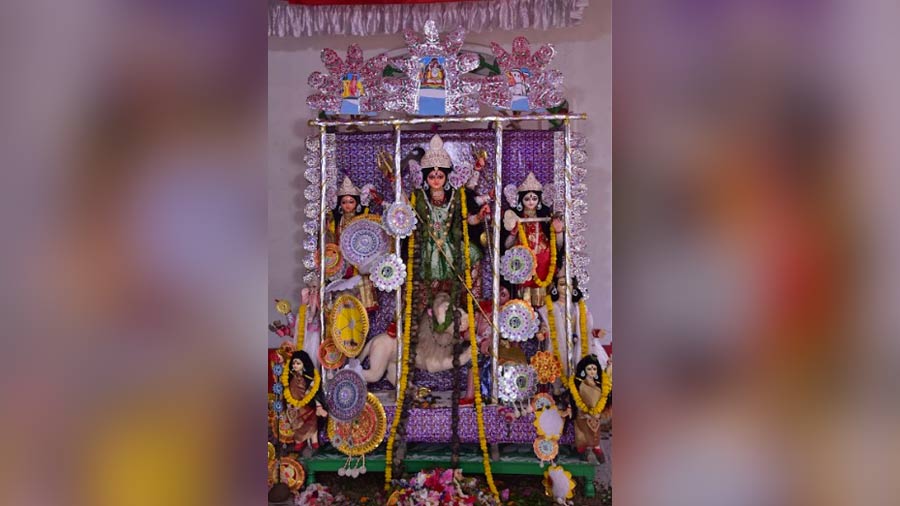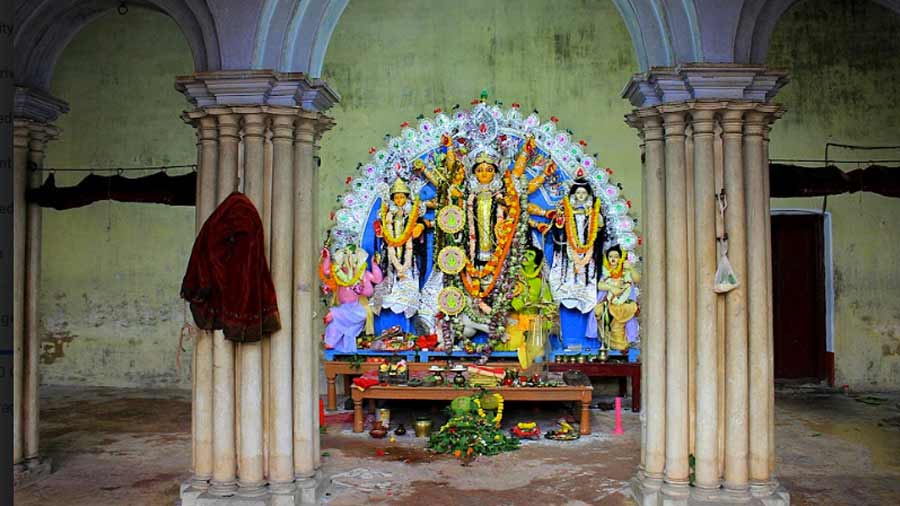The town of Baksa, in the Serampore subdivision of Hooghly district, is home to quite a few families and traditional households that have been celebrating Durga Puja for over 200 years. The Mitra family of Baksa is one of them. In the past, there were seven branches of the Mitra family that used to conduct the annual celebration on rotation. At present, this number has reduced to one. But their dedication towards the annual Puja hasn’t changed over the years.
The Mitras have long worshipped Lord Shiva, Raghunath and other deities. According to family history, ancestor Bhavanicharan Mitra — the dewan of the Burdwan maharaja — had heard the sound of bells and the chanting of hymns to Lord Shiva while taking an evening stroll on the banks of river Saraswati. Interestingly, there was no Shiva temple in the vicinity. When this continued to happen for a while, Bhavanicharan built 12 Shiva temples under the patronage of the maharaja, next to the crematorium on the river bank.

Bhavanicharan Mitra built 12 Shiva temples under the patronage of the Burdwan maharaja Amitabha Gupta
Within a short span of time, after these Shiva temples were built, Bhrukutiram Mitra, a distant relative of Bhavanicharan Mitra, built a nine-pinnacled Raghunath temple in Baksa village, and instated deities of Raghunath and Radhakrishna.

The nine-pinnacled Raghunath temple built by Bhrukutiram Mitra in 1793 Amitabha Gupta
Over the years, the family began celebrating Durga Puja on a grand scale. Parasuram Mitra and his lineage had become very prosperous by then, and it was this branch of the Mitra family that built a Durga dalan at their home and started worshipping the goddess annually. Ranjan Mitra, a senior member of the family, however, insists that their Durga Puja started at least 400 years ago, much before the thakur dalan was built.
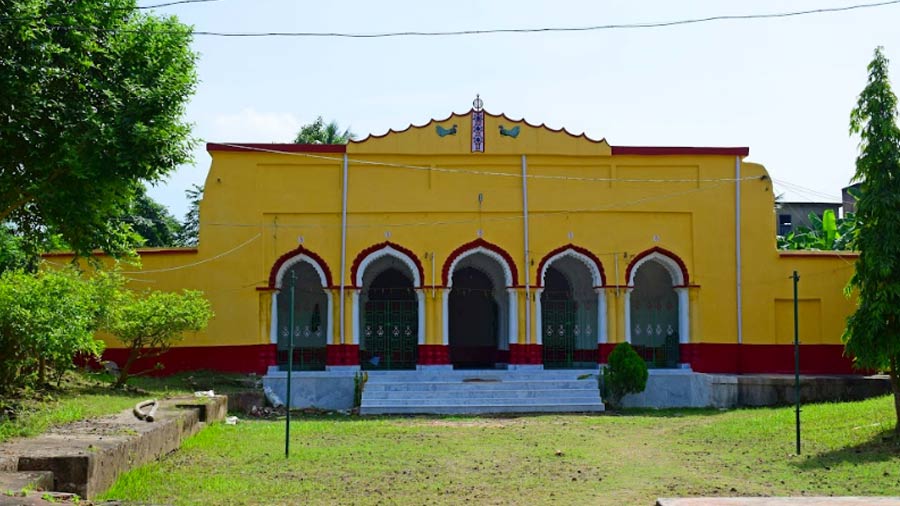
The Durga 'dalan' of the Mitra family Amitabha Gupta
On the day of Ulto Rath, a bamboo stem is worshipped — khunti pujo as it is called — at Mitra residence, which later forms a part of the kathamo, or the wooden framework of the deity. Although there is a temple of Raghunath Jiu in the house, the Mitra family follows Shakta rituals, as per the Kalika Puran, for their Durga Puja.
The bodhon, or the invocation of Goddess Durga, is done some 10 to 15 days before Durga Puja actually begins. Chandipath also starts from the day of bodhon.
Ranjan further informs that their Durga Puja carries out a unique ritual — they worship three nabapatrikas. After the ritual of adhibas (protecting the mangal ghot from evil forces) is complete, the nabapatrika is placed beside the mangal ghot for the first time on Navami of Krishna Pakkha, the day after bodhon.
A fresh ritual of adhibas is again carried out a day after Mahalaya, on pratipad (first day) of Sukla Pakkha. The next day, on Dwitiya, the earlier nabapatrika is immersed, and a new one is instated on the thakur dalan. Finally, on Saptami, the third nabapatrika is placed beside the idol of Ganesh, before which the second nabapatrika instated on Dwitiya is immersed. It is the third nabapatrika that is worshipped throughout the four days of Durga Puja.
There is another ritual unique to the Mitra family of Baksa. On the day of bodhon, a small rectangular patch on the thakur dalan is filled with soil and seeds of different grains. By the time Durga Puja begins, sprouts start emerging from the soil. Since the Mitra family’s zamindari income came mainly from agriculture, this act of sowing seeds that eventually sprout is symbolic of a bountiful harvest and signifies that Goddess Durga brings prosperity and abundance to the family.

A rectangular patch of soil on the ‘thakur dalan’, where seeds are sown. The sprouts come out by the time Durga Puja begins Amitabha Gupta
On the day of Sashthi, the idol of Devi Durga is placed in the thakur dalan, and the goddess is adorned with clothes and jewellery. All three female deities — Durga, Lakshmi and Saraswati — are dressed up in Benarasi saris. The idols of Ganesh and Kartik are clothed in garments made from garad fabric. Like in many other household Pujas, the twin deities of Jaya and Bijoya flank Goddess Durga and her family on both sides.
Before the puja starts, the idol of Raghunath Jiu is brought from the Raghunath temple to the thakur dalan, where the mangalchandi ghot also is placed. Raghunath Jiu is taken back to his temple after each day’s puja and brought back the next morning.
On Saptami, after the goddess is given a symbolic bath with sacred water, a twig from a neem tree is worshipped. The neem twig is believed to be the toothbrush for the goddess.
The Mitra family of Baksa still carries out animal sacrifices during Durga Puja. Ranjan adds, “We sacrifice a goat on Saptami, another on the eve of Sandhi puja, five goats and one sheep on Navami are sacrificed in front of the Goddess. When the sacrifices are carried out, Raghunath Jiu is wrapped in a cloth. Being a Vaishnav god, he doesn’t need to witness the bloodshed.”
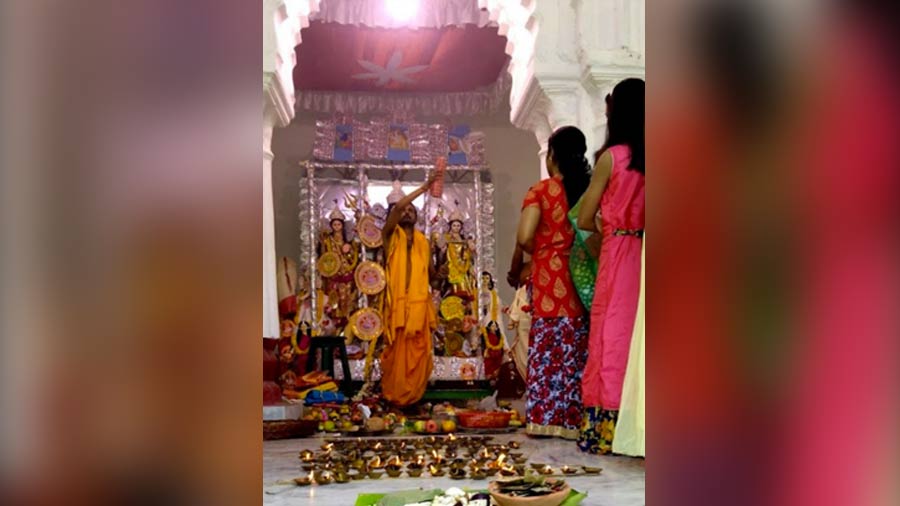
Sandhi puja in progress at the Mitra family household Mitra family
The first offering from the Mitra household goes to temples of local deities — Baidya Mata and Vishalakshmi Mata. On Navami, a goat, along with some naibadya (food offering), are sent to Baidya Mata’s temple. Only after the goat has been sacrificed at the temple, the Navami ritual of animal sacrifice can begin in the Mitra household.
During the four days of the Puja, the goddess is offered various delicacies, including luchi, 100 narus made with grated coconut, panchkarai, mewa, cashews, raisins and a number of fruits. In addition to all these, an uncooked fish with its scales intact is offered to the goddess.
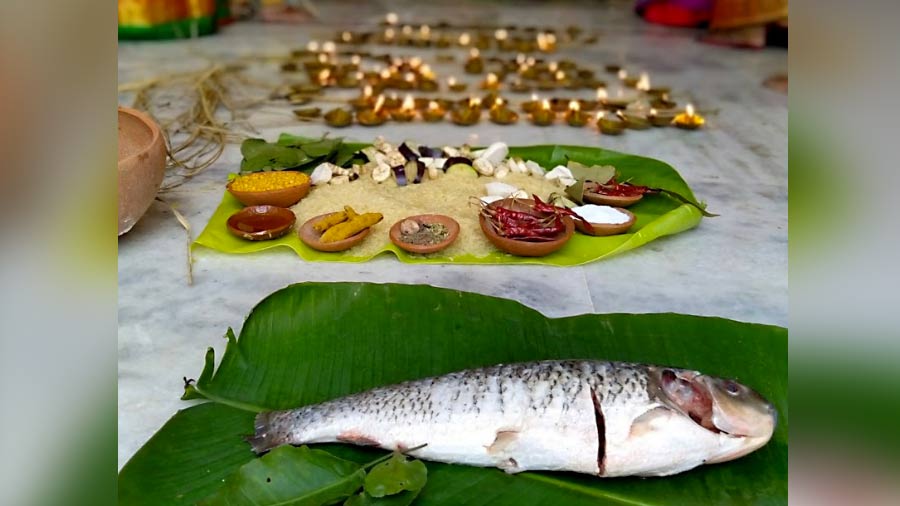
An uncooked fish with all its scales intact is offered to Goddess Durga on all days of the Puja Mitra family
Before immersion on Dashami, Goddess Durga is brought down from the thakur dalan to the courtyard. The idol of Raghunath is placed on the pavement outside the Raghunath temple that faces the courtyard. The rituals of boron and sindoor khela take place in front of Raghunath.
Before bidding a final goodbye to the goddess, the family carries out the ritual of kanakanjali — just like they send their daughter to her in-laws’ place. Goddess Durga, Saraswati and Lakshmi are decked in red-and-white cotton saris, while Ganesh and Kartik wear cotton dhotis.
After the immersion, family members visit the Raghunath temple and have charanamitra. Once back home, the Mitra family stand in front of the photos of their ancestors and write ‘Sri Sri Durgamata Sahay’ on banana leaves with aalta.
